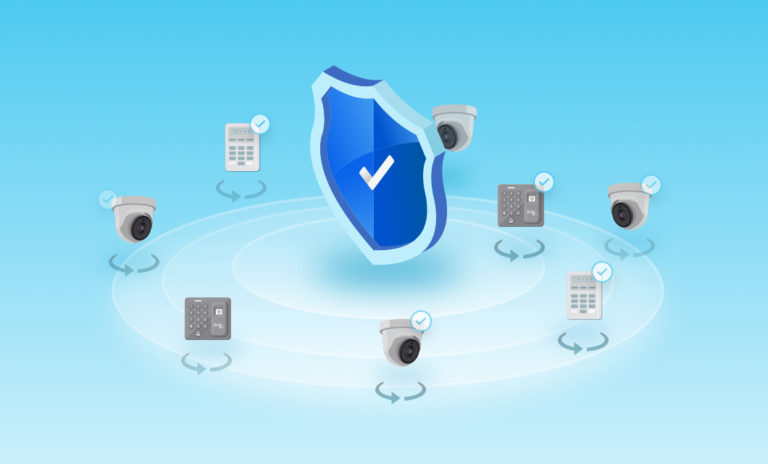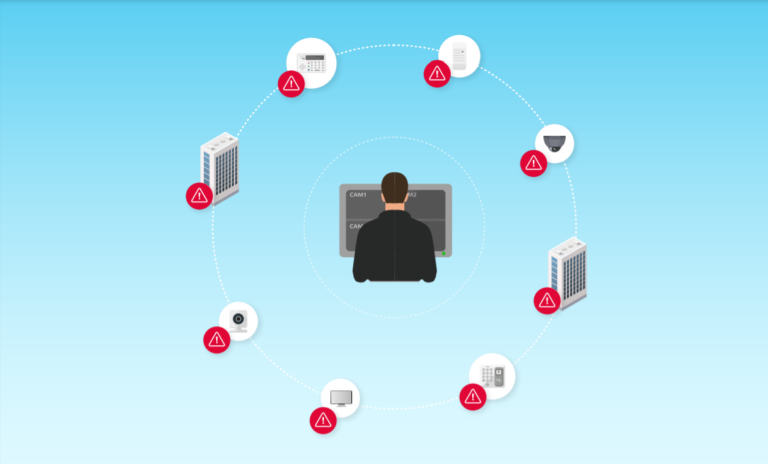
While managing overall physical security operations at one site can present significant challenges for organizations to address, having physical security devices spread across multiple sites adds an entirely different level of complexity to those challenges. Handling even a single site’s devices can involve managing devices of various models, which were made by multiple manufacturers, were produced at different times, and are running different software. Beyond that complexity, a multi-site distribution of physical security devices often means having a range of staff, protocols, and even requirements.
But it’s worth keeping in mind that what conventionally makes the multi-site management of physical security devices so cumbersome is a lack of real-time data, remote access, and automation. Not only does this reality create a risk that a device will go offline for an extended period before any team member notices, but it means that both routine maintenance and troubleshooting is oftentimes conducted manually on-site. Those challenges can also present a serious need to invest in coordination and communication across teams, especially because devices often fall into a sort of gap between the responsibilities of IT and physical security teams.
Today, however, these challenges don’t need to be so, well, challenging. The complexity involved in managing physical security devices across multiple sites can be addressed with IoTOps, which uses the power of automation to streamline IoT device management. From performing routine maintenance to detecting anomalies, diagnosing problems, and rectifying them remotely, IoTOps can make the operational management of physical security devices both more reliable and more efficient.
Specifically, here are four ways that IoTOps addresses the key challenges stemming from the complexity of managing devices across multiple sites:
1. Providing Real-Time Status Alerts for IoT Device Management
As with any technology, outages occur. But when those outages happen to physical security devices, it can present a real risk to the organization. For instance, imagine if a university dorm’s security camera was down during a security incident, or if a vehicle access control barrier was offline during a busy factory delivery period.
The process of verifying device statuses is often done manually by different teams, resulting in inefficiencies and high overhead costs—as well as security and liability risks if not done properly. For example, a video management system (VMS) provides a list of devices and statuses that need to be verified individually by scrolling through long lists of devices. When these devices are deployed at scale across multiple sites, consistently providing manual status verifications in real time becomes a virtually impossible task.
To address this challenge, IoTOps helps ensure that all devices stay operational, secure, and compliant—with minimal human intervention required. For instance, SecuriThings Enterprise constantly monitors the operational status of each physical security device in a fleet by collecting and analyzing data directly both from those devices and from their management systems, alongside network and other data sources. Using real-time metrics reflecting device health and status—including CPU and RAM usage, temperature, and more — SecuriThings Enterprise automatically detects signs that a device has gone offline or encountered another type of problem. It then immediately alerts team members so that they can promptly address the problem or trigger an action in a 3rd party platform such as an IT helpdesk.
2. Simplifying Troubleshooting with IoT Device Management
When teams become aware of an issue with a physical security device, they must figure out how to fix it—but that’s not always a simple task. The lack of edge visibility leads to a limited analysis of operational issues, often resulting in significant back-and-forth between teams to determine the exact issue and who is responsible for fixing it. For example, is the issue related to a switch, the network, a PDU, the device itself, or the management solution?
Lack of visibility causes unnecessary support tickets and noise between teams—an especially challenging situation for devices deployed across multiple locations. The slow process of diagnosing an issue in turn delays the process of identifying the right solution and taking action to resolve the issue.
In addition to detecting device issues in real time, IoTOps can use key metrics to identify those specific issues. The smart alerts that SecuriThings automatically sends our customers when device issues are detected pinpoint the specific issues, including root cause analysis and suggested resolutions. One key way our technology makes these determinations is by grouping a series of issues based on their lowest common denominator.
For example, let’s say there is an outage of 30 devices SecuriThings detects that they are down, it then checks one level above to find a factor that all of those devices have in common, such as a faulty switch. SecuriThings can then diagnose the issue, helping the organization to rapidly identify the root cause and troubleshoot the issue. A typical setup looks like: Overview > Site > VMS > Recording Server > Switches/PDU > Device
3. Handling Incidents Rapidly with IoT Device Management
A traditional break-fix process requires a technician to be dispatched to the site of a problem to check and resolve it. For example, if an access control barrier is not working correctly, the enterprise will authorize a truck roll for a technician to drive out to the site and look at the problem. But until that technician can get there, company vehicles cannot get in or out, and important deliveries of materials or products cannot be made, resulting in high costs for the business. Relying on manual tech dispatches to multiple sites leads to increased downtimes with excessive time to resolution, resulting in unmet SLAs.
Rather than dispatch a costly technician to manually look at an issue, IoTOps uses analytics based on aggregated data to achieve valuable real-time insights and actions required at any point in time. For example, when the SecuriThings Enterprise detects a problem affecting a physical security device, a centralized dashboard will indicate whether the device can be fixed with a simple refresh, whether it is compromised by a cybersecurity issue, or whether it truly requires a team to be dispatched to investigate. These insights shorten the time to resolution and significantly save on operational costs for the organization.
4. Bridging Divides Efficiently
When physical security devices are deployed across multiple enterprise sites, the differences between those sites often create inconsistencies and configuration issues that must be addressed. Typically, a given site will use between two and five different brands for any given type of physical security device. Different device manufacturers, in turn, rely on different software to run these devices—software that is produced by multiple vendors. Mergers and acquisitions often add another layer of complexity, as each entity has its own legacy devices, processes, and platforms.
This presents a variety of challenges, given that multi-site deployments typically have no alignment or real-time visibility into device status. Addressing those challenges conventionally often requires physical security teams to coordinate with IT operations, infrastructure and network staff, security operations center (SOC) professionals, and cybersecurity teams.
IoT device management, on the other hand, simplifies these challenges by using automation to drive consolidation across fragmented devices and management systems. In offering our solution to customers, we at SecuriThings enable those organizations to eliminate much of the inconsistency and inefficiency that result from having so many physical security devices spread across multiple sites.
For example, when our solution monitors varied physical security devices, our customers know that if a problem is detected, the appropriate team members will be notified in real time—minimizing the need for cumbersome coordination across teams. In addition, SecuriThings Enterprise seamlessly integrates with third-party platforms, such as ticketing systems and the rest of a customer’s cybersecurity stack—ensuring streamlined, actionable data that helps each multi-site organization with future planning and decision making.
IoT Device Management Across Multiple Sites: The Big Picture
Although the number of sites across which an organization’s physical security devices are deployed does not by itself determine the complexity of managing those devices, it is certainly a contributing factor. Manually managing devices at even a single location has its share of challenges, and spreading those devices across sites makes their operational management more complicated and time-consuming.
Similarly, while IoTOps can streamline the operational management of physical security devices at even a single location, dealing with devices across multiple sites makes the benefits of IoTOps technology (such as SecuriThings Enterprise) even more obvious.
Keep in mind: Those benefits aren’t just a matter of maximizing efficiency and minimizing the amount of work involved in managing physical security devices. IoTOps helps ensure that devices stay functional and that any issues that do arise get resolved as quickly and efficiently as possible, so that those devices can do their jobs as reliably as possible.
In other words, using IoTOps to manage physical security devices spread across multiple sites doesn’t just save time. It helps keep those sites safe.
FAQs
What are the key benefits of automating IoT device management?
Automating IoT device management provides several key benefits, including increased efficiency, reduced operational costs, and improved security. Automation allows organizations to monitor devices in real-time, ensuring they are functioning correctly without requiring constant manual intervention. It also enables automatic updates and maintenance, reducing the risk of human error and ensuring that all devices remain compliant with security standards. By automating routine tasks, organizations can focus their resources on higher-value activities, enhancing overall operational effectiveness.
How does IoT device management improve security across multiple sites?
IoT device management enhances security across multiple sites by providing centralized control and real-time monitoring of all connected devices. This centralized approach allows organizations to quickly identify and address vulnerabilities, such as outdated firmware or weak passwords, that could be exploited by cybercriminals. Additionally, IoT device management solutions often include predictive maintenance features, which help prevent device failures that could compromise security. By ensuring that all devices are secure and functioning properly, IoT device management plays a crucial role in safeguarding physical and digital assets across dispersed locations.
How can IoT device management reduce downtime and maintenance costs?
IoT device management reduces downtime and maintenance costs by enabling proactive monitoring and predictive maintenance. By continuously collecting and analyzing data from devices, these systems can detect potential issues before they lead to failures. This allows organizations to address problems early, preventing costly downtime and minimizing the need for emergency repairs. Additionally, remote troubleshooting and automated maintenance features reduce the need for on-site technician visits, further lowering operational costs and improving the uptime of critical devices.
What challenges do organizations face without effective IoT device management?
Without effective IoT device management, organizations face several challenges, including inconsistent device performance, increased security risks, and higher operational costs. Managing a large number of devices manually can lead to oversights, such as missed updates or unnoticed malfunctions, which can compromise both security and efficiency. Furthermore, without centralized management, organizations may struggle with coordinating across multiple sites, leading to inefficiencies and potential gaps in security coverage. These challenges highlight the importance of implementing robust IoT device management solutions to ensure seamless, secure operations.
How does IoT device management support compliance with organizational policies?
IoT device management supports compliance with organizational policies by providing tools for centralized monitoring, reporting, and enforcement of security protocols. These systems can automatically apply updates, enforce password policies, and ensure that all devices adhere to the organization’s security standards. Additionally, IoT device management solutions often include auditing and reporting features, allowing organizations to demonstrate compliance with internal policies and external regulations. By maintaining a consistent and secure device environment, IoT device management helps organizations avoid compliance violations and the associated penalties.




